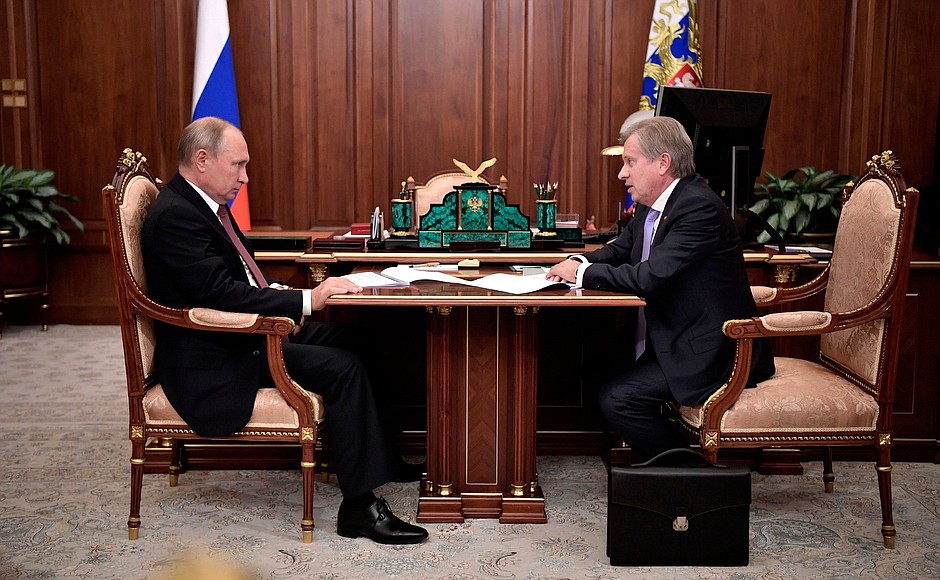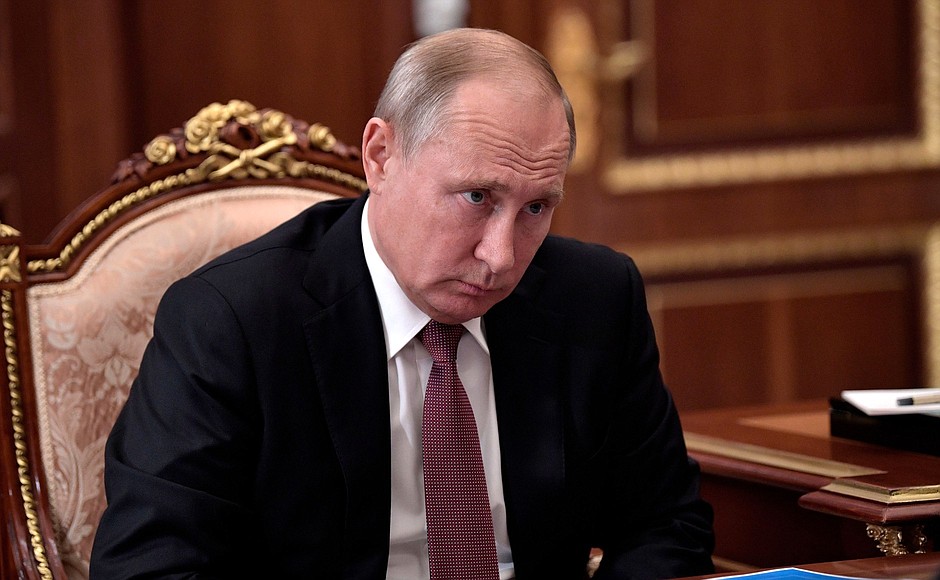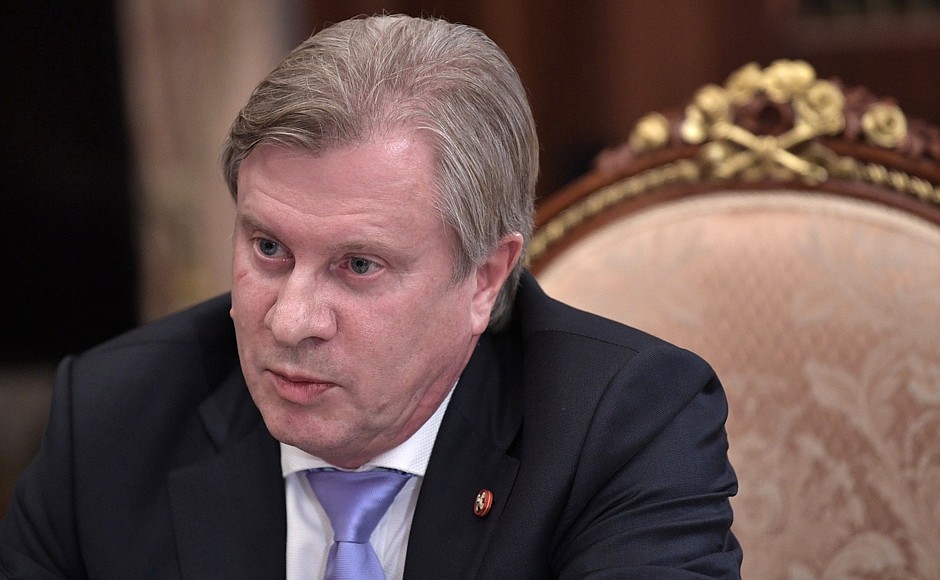President of Russia Vladimir Putin: Mr Savelyev, when you told me about Aeroflot’s development strategy some time ago, you spoke about the creation of regional hubs. Let us begin with this plan, and then we will discuss transportation as well as other subjects.
General Director of Aeroflot – Russian Airlines Vitaly Savelyev: Mr President, I have prepared a short presentation. I would like to say a few words about our plans for the next five years.
Aeroflot will celebrate its 100th anniversary in 2023, which is in five years, and we wanted to focus above all on the key projects we can implement by that deadline.
The first objective is to transport between 90 and 100 million passengers. It is a feasible target – I will tell you why – and our top priority.
Secondly, we want to increase connecting traffic from Southeast Asia, which is a challenge we can deal with. This is why we need a regional hub. Under your May Executive Orders, which highlight the development of transportation facilities specifically in central Russia, we propose creating four basic sites, one of which will be developed as a hub. I would like to tell you about it.
Another target is to build and use 200 Russian-made aircraft, including the MC-21 and 100 Sukhoi Superjet craft we already have contracts for, plus the 50 aircraft at our disposal.
Of course, we confirm our priority policy, that is, the continued digitalisation of our company so that we will comply with the best international standards available.
Let me move on. This slide, Mr President, shows that not long ago, in 1990, Aeroflot was listed in the Guinness Book of Records. We provided services to 139 million people; this record has been broken recently after the merger of two US companies, US Airways and American Airlines. Nobody could break the record until then. This was in 1990. As you see, in 1994 the traffic dropped to 3.1 million. It means that Aeroflot broke into 300 companies at the time, and in all, our airlines serviced some 30 million passengers. These significant losses happened during the collapse of the Soviet Union.
Vladimir Putin: In 1994?
Vitaly Savelyev: Yes, just recently.
Vladimir Putin: 3 million people in all?
Vitaly Savelyev: Yes, 3 million by Aeroflot and 30 million in total.
Vladimir Putin: And in 1990 it was 139 million?
Vitaly Savelyev: Yes, it was a single company and it serviced that many passengers.
I joined Aeroflot in 2009. Together with two affiliates, the company carried 11.1 million people. In 2017, we were officially included in the top-20 global carriers. As Aeroflot Group we ranked 19th with 50.1 million passengers. This year we will increase the number to 56 million people. We need to reach this point (we call this chart “the smile”) to recreate this “smile” so that Aeroflot is again a global airline and takes its place among the top-10 airlines. There are mergers and acquisitions on the market and we really want to stay there. This is our number one task.
What potential do we have to achieve that? This is the next slide. The left part of the diagram shows that the global market’s annual growth is some 6.5 percent. The European figure is a little bit smaller, because the market is denser, with 4 percent. But in both cases, the main growth drivers are low-cost airlines. I will tell you more about our Pobeda low-cost airline that is developing successfully and is already in the top 10 in Eastern Europe in terms of passengers carried, due to your support. This year, it will carry over 7 million people. This is a serious foundation and we will continue working in this field.
We see that the market is growing and low-cost airlines are operating there. What will happen to our Russian market? Despite the current situation, the growth rate was 10.4 percent until last year. According to experts, in 2017 all airlines carried 124 million Russians, and Russian airlines alone carried 105 million people. There is a 6.4 percent growth; therefore, it is possible to reach 189 million by 2023. This is why we want at least a half, so that it would not exceed half of the controlling stock, the market share. Nevertheless, we can consider this number and take on half.
What was the growth rate? Here is an important index: the global market grew 1.7 times between 2009 and 2017. The Russian market grew 2.2 times. In this period of time, Aeroflot grew 4.5 times, so that our growth rate has been increasing steadily despite all the crises that happened in the nine and a half years that I have worked there.
Why do we need a new strategy? We have achieved the goals we set in 2009. Back in that year, we ranked 68th in terms of passenger traffic, and now we rank 19th. In Europe, we took the 15th place, and now we are in 5th place, not considering two low-cost airlines, Ryanair and EasyJet, these are different projects. Proceeding from this we decided to take up new goals for the next five years, so that we can load the company and it would show even better results.
What would it be, 90–100 million? It was 33 last year, it will be 36 this year, but 52 million is the limit and we believe we should not exceed it because Aeroflot belongs to the premium market segment. Let me remind you that our fleet is the youngest in the world: over 100 aircraft. We want to stay in the premium segment.
As for Pobeda, which has already carried five million this year and will carry seven, we need to load it significantly. The growth rate will be very high and we can reach 25–30 million passengers by 2023 as part of the development of this low-cost airline.
I will elaborate on Rossiya Airlines further. We would like to keep it and make it a social company, because we inherited no new craft from Transaero, and it is very difficult to compete with such craft. Considering the social load and social transfers we make, we would like to retarget these aircraft. We have upgraded them and added new economy class planes because fixed-price tickets are only available in the economy class. This is why we will use Rossiya Airlines. Aeroflot will fly too, but mostly Rossiya. And Aurora, a regional company that will double in size by 2023.
Vladimir Putin: In the Far East?
Vitaly Savelyev: Yes, it operates in the Far East. There was a merger between Vladivostok Air and SAT Airlines.
Thanks to your support, Mr President, Pobeda is developing successfully. Last year I told you that one million passengers have used Pobeda since 2014, when we established Dobrolyot, which is now under European sanctions. So, two million customers who had never flown before used Pobeda by this year. I mean people who only travelled by railway or car before.
This means Pobeda is popular. It is complicated, it has many issues and complaints, but its flights are 94 percent full, and it has been producing 3.5 billion of net profit per year for two years now. According to the business plan, our investment in Pobeda should have been $100 million. We have invested 50. Two expert estimations, a direct comparison and a mathematical model, show that it is worth $612 million today. It will continue to develop successfully.
This slide shows that we are increasing our proportions: we have adjusted Aeroflot’s schedule based on the fact that jet fuel has become more expensive; in order for airfares to remain stable and to keep fuel rates flat, we have redistributed the load a bit. If Aeroflot takes 56 percent of the Far East, and Rossiya takes on 44, the proportion will be reversed: Rossiya will fly a bit more and Aeroflot a bit less in order to use Aeroflot planes in the Asian markets. But this will mean a 9 percent increase in base airfare sales to the public in general. And, as always at the end of the year I have a letter on flat rates that I would like to discuss with you separately.
This slide shows our unique location. This spot in Southeast Asia shows about 520 million tourists constantly going to Europe. We want to take a bit of this. If you look at this diagram, it shows that the distance to Europe is much shorter if you travel through Russia. And Aeroflot has the lowest prices; we have already worked on that. This is why we can hope that we will win this traffic.
For the second year in a row, we have become the favourite foreign company in China. We have beaten Qatar Airlines, and that is a five-star company. Today we are the number one carrier for the destinations shown here. This is why we can really increase passenger traffic, which is very important for our financial and industrial stability, from 5 million to 10–15 million. This is quite possible.
And now back to the hubs. We want to fly from Moscow. Of course, Sheremetyevo is our home base, but we are successfully growing, and Sheremetyevo is being developed, too. Nevertheless, we can see that there will be a limit for us there. Today about 85 percent of our traffic is through Sheremetyevo. But we would like to discuss four locations: Sochi where we will create a hub instead of just a destination; Yekaterinburg will be another hub, and Novosibirsk and Krasnoyarsk.
We are currently in talks with the airports. And we hope for either Krasnoyarsk or Yekaterinburg (this is exactly the distance from China from where we will pick up passengers: either from Krasnoyarsk to Europe or from Yekaterinburg to Europe). We will build a hub in one of these cities, with a transit schedule and transiting traffic. We will increase it step by step and, without flying to Moscow, we will be able to…
Vladimir Putin: And Vladivostok?
Vitaly Savelyev: We continue developing Vladivostok; our regional company, Aurora, which will make regional flights, will be based there. This is why Vladivostok will also become a hub; we will double the traffic and will also develop Khabarovsk. This concerns regional flights.
As for domestic technology. We already have 50 Sukhoi Superjets in our fleet today, and we have just signed an agreement for another 100 jets in your presence in Vladivostok.
Vladimir Putin: I do remember.
Vitaly Savelyev: And we are waiting for 50 MS-21 jets. We hope to start using all these 200 jets by the year 2023. We will have to get rid of some of the fleet, but about 190 domestic aircraft will be in operation by then. We do hope that all our plans will come true.
And the last point is digitalisation. I can tell you that we have retained our positions when it comes to this. As for business processes that are digitised, and the Aeroflot services, we hold the fourth place. That is, we maintain our position.
What will happen if we do all this? We will transport about 90–100 million passengers, and 10–15 million international transit passengers; the total fleet will comprise 520 craft, 190 of which will be domestically produced. Group revenues will be 1.3 trillion rubles, and market capitalisation, according to our estimates, may grow to 400 billion rubles.
Vladimir Putin: What about passenger traffic this year?
Vitaly Savelyev: Passenger traffic is increasing. This year we will transport 56 million people compared to 50 million last year. Aeroflot will grow by about 10 percent, and the entire group by 11.8. But Pobeda will show substantial growth. Of course, it is in great demand. Wherever it flies, prices fall instantly by 25 percent. Pobeda is tough, but all the governors want it to fly, because, after all, Pobeda is in great demand with those who cannot afford to fly with bigger companies. Therefore, we will develop it.
Vladimir Putin: Let me see you proposals on flat rates, please.
<…>


